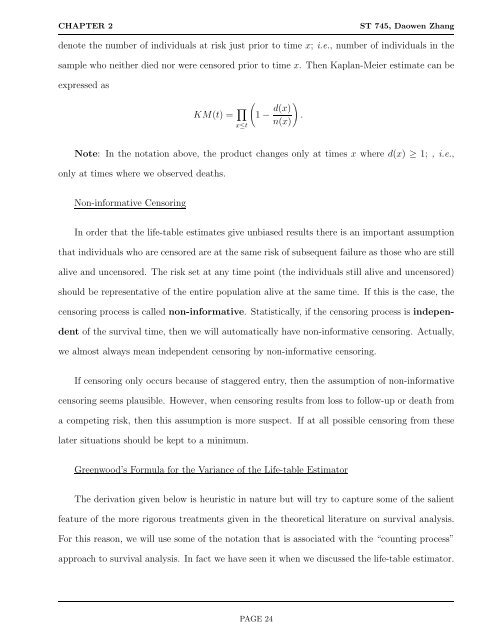2 Right Censoring and Kaplan-Meier Estimator - NCSU Statistics
2 Right Censoring and Kaplan-Meier Estimator - NCSU Statistics
2 Right Censoring and Kaplan-Meier Estimator - NCSU Statistics
Create successful ePaper yourself
Turn your PDF publications into a flip-book with our unique Google optimized e-Paper software.
CHAPTER 2 ST 745, Daowen Zhang<br />
denote the number of individuals at risk just prior to time x; i.e., number of individuals in the<br />
sample who neither died nor were censored prior to time x. Then <strong>Kaplan</strong>-<strong>Meier</strong> estimate can be<br />
expressed as<br />
KM(t) = �<br />
�<br />
1 − d(x)<br />
�<br />
.<br />
n(x)<br />
x≤t<br />
Note: In the notation above, the product changes only at times x where d(x) ≥ 1; , i.e.,<br />
only at times where we observed deaths.<br />
Non-informative <strong>Censoring</strong><br />
In order that the life-table estimates give unbiased results there is an important assumption<br />
that individuals who are censored are at the same risk of subsequent failure as those who are still<br />
alive <strong>and</strong> uncensored. The risk set at any time point (the individuals still alive <strong>and</strong> uncensored)<br />
should be representative of the entire population alive at the same time. If this is the case, the<br />
censoring process is called non-informative. Statistically, if the censoring process is indepen-<br />
dent of the survival time, then we will automatically have non-informative censoring. Actually,<br />
we almost always mean independent censoring by non-informative censoring.<br />
If censoring only occurs because of staggered entry, then the assumption of non-informative<br />
censoring seems plausible. However, when censoring results from loss to follow-up or death from<br />
a competing risk, then this assumption is more suspect. If at all possible censoring from these<br />
later situations should be kept to a minimum.<br />
Greenwood’s Formula for the Variance of the Life-table <strong>Estimator</strong><br />
The derivation given below is heuristic in nature but will try to capture some of the salient<br />
feature of the more rigorous treatments given in the theoretical literature on survival analysis.<br />
For this reason, we will use some of the notation that is associated with the “counting process”<br />
approach to survival analysis. In fact we have seen it when we discussed the life-table estimator.<br />
PAGE 24
















